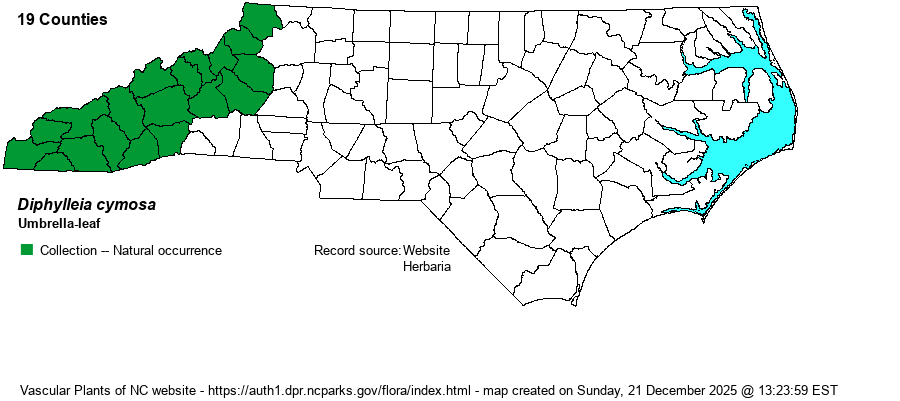| Author | Michaux | |
| Distribution | Throughout the Mountains; does not occur downstate.
This is a tight Southern Appalachian endemic species, ranging from southwestern VA to northwestern SC and northern GA. | |
| Abundance | Fairly common to locally common in middle to higher elevations, nearly across the Mountains; not numerous in the lower elevations. It is, by far, more common in NC than in any of the five states where it occurs, in part because NC contains about half of the geographic range of the species. | |
| Habitat | This is a species of seepages in cold to cool montane forests, usually in Rich Cove Forests and in Northern Hardwood Forests, as well as in Boulderfield Forests. It also occurs along the margins of forested streams. |
| Phenology | Blooms in May and June -- after the main floral push of spring wildflowers in the mountains. Fruits in July and August. | |
| Identification | This is a quite robust herb, with among the largest leaves of any species in the state. It grows to 2-3 feet tall, with two very large peltate leaves, with the petiole attaching near the leaf base but not at it. The leaves are generally reniform to rounded, deeply cleft in the middle to yield two fan-shaped portions, with the entire leaf about 1-1.5 feet across and almost 1 foot long. The margins are moderately cleft such that there are as many as 10-15 triangular lobes. The flower stalk emerges opposite the lower (larger) leaf, with a naked stalk often 6 inches long, topped by a cluster of white flowers. Each flower has 6 petals and has a spread of about 2/3-inch across; in addition, the cluster usually has 10 or more flowers in bloom in a dense dome, very striking. About two months after flowering the peduncles turns bright red, and the fruits (drupes) are bright blue and rounded, each about 2/5-inch across. Thus, the combination of bright red and blue atop the plant in late summer is bound to attract attention, as much as will the huge leaves. Needless to say, these plants attract attention at all times (when they are above ground), and thankfully the species is fairly common in our montane coves, at least where there is some seepage in the coves. | |
| Taxonomic Comments | None
| |
| Other Common Name(s) | American Umbrella-leaf, Pixie-parasol | |
| State Rank | S4 | |
| Global Rank | G4 | |
| State Status | | |
| US Status | | |
| USACE-agcp | | |
| USACE-emp | FACU link |

